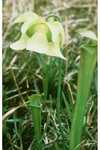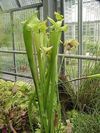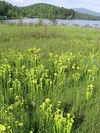Genus Sarracenia
Sarracenia is a genus comprising 8 to 11 species of North American pitcher plants.Species in the genus Sarracenia of plants
Yellow trumpets - Among members of Sarracenia the floral coloring of Sarracenia alata is remarkably varied. Flowers may be cream to white, greenish, yellow or reddish. As the floral color variations exist within populations hundreds of miles from any other Sarracenia species, these variations cannot be attributed to hybridization.
Yellow pitcherplant - Like other members of the genus Sarracenia, the yellow pitcher plant traps insects using a rolled leaf, which in this species is a vibrant yellow in colour, and up to over a metre in height . The uppermost part of the leaf is flared into a lid , which prevents excess rain from entering the pitcher and diluting the digestive secretions within. The upper regions of the pitcher are covered in short, stiff, downwards-pointing hairs, which serve to guide insects alighting on the upper portions of the leaf towards the opening of the pitcher tube. The upper regions are also brightly patterned with flower-like anthocyanin markings, particularly in the varieties S. flava var. rugelii and S. flava var. ornata: these markings also serve to attract insect prey. The opening of the pitcher tube is retroflexed into a 'nectar roll' or peristome, whose surface is studded with nectar-secreting glands. The nectar contains not only sugars, but also the alkaloid coniine , which probably intoxicates the prey. Prey entering the tub
Crimson pitcherplant - In cultivation, S. leucophylla is generally less tolerant of stagnant water conditions and requires adequate soil drainage while still retaining requisite moisture levels to prevent root rot. Several clones are recognized: 'Schnell's Ghost', a yellow-flowered clone with little red in the pitchers ; 'Hurricane Creek White', a group of predominantly white plants from Hurricane Creek, AL; 'Tarnok', a mutant form which produces a showy, although sterile, double flower; and 'Titan', an especially tall and robust form that may produce fall pitchers greater than 38 inches in height. Despite its native range in the southeast US, S. leucophylla is remarkably hardy and can be grown outside even in USDA zones 6 and colder with careful winter protection.
Hooded pitcherplant - In 1788, the first description of S. minor was written by Thomas Walter. The specific epithet minor means "small" and refers to the typical size of the pitchers. The common name refers to the characteristic lid of this species.
Green pitcher plant - Like other members of the genus Sarracenia, the Green Pitcher Plant traps insects using a tubular rolled leaf which collects digestive juices at the bottom. The pitcher tube of this species is similar to that of Sarracenia flava, but has a wider pitcher mouth and neck and is usually somewhat shorter, reaching only 60 cm .
Parrot pitcherplant - Sarracenia psittacina employs the same trapping mechanism as Darlingtonia californica, using a small entrance in the pitcher mouth, which prey goes through in search of more nectar that was produced by the plant on the rim of the pitcher mouth. The prey is then confused by light shining through what appear to be false exits and crawls toward the brighter area down into the pitcher. Criss-crossed downward-facing hairs densely line the interior of the pitcher, forcing the prey further into the pitcher to an area where digestive enzymes such as proteases are prevalent in the liquid.






